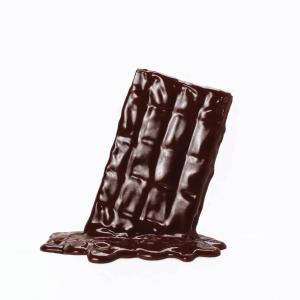Physically changing materials
Physical changes affect some of the properties of an object, for example, stretching a hair tie changes its shape but not necessarily its colour. Physical changes can also change the properties of the material the object is made of, for example hair ties often become larger over time as they no longer bounce back to their original shape after many periods of stretching (the material has lost elasticity). Scrunching and folding may change the physical shape of an object but not change the material at all.
A chemical change is where a substance is transformed into a new substance (or substances) at the molecular level. When you burn a piece of toast, the bread changes into charcoal, carbon dioxide and water. Other examples of chemical change include rusting and mixing sodium bicarbonate with acid, such as citric or tartaric, in water to create carbon dioxide and water.
In the early years, students study whether different actions (combinations of forces) change the shape of objects, and whether these physical changes affect the material the objects are made of. The actions include:
- Bending: causing an object, such as a wire or a pipe cleaner, to become curved. Bending involves parts of the object being pushed or pulled towards each other, for example pushing your two hands together, or pushing down on a sheet of cardboard that is held on a table by a heavy object (force arrows indicate direction of force).
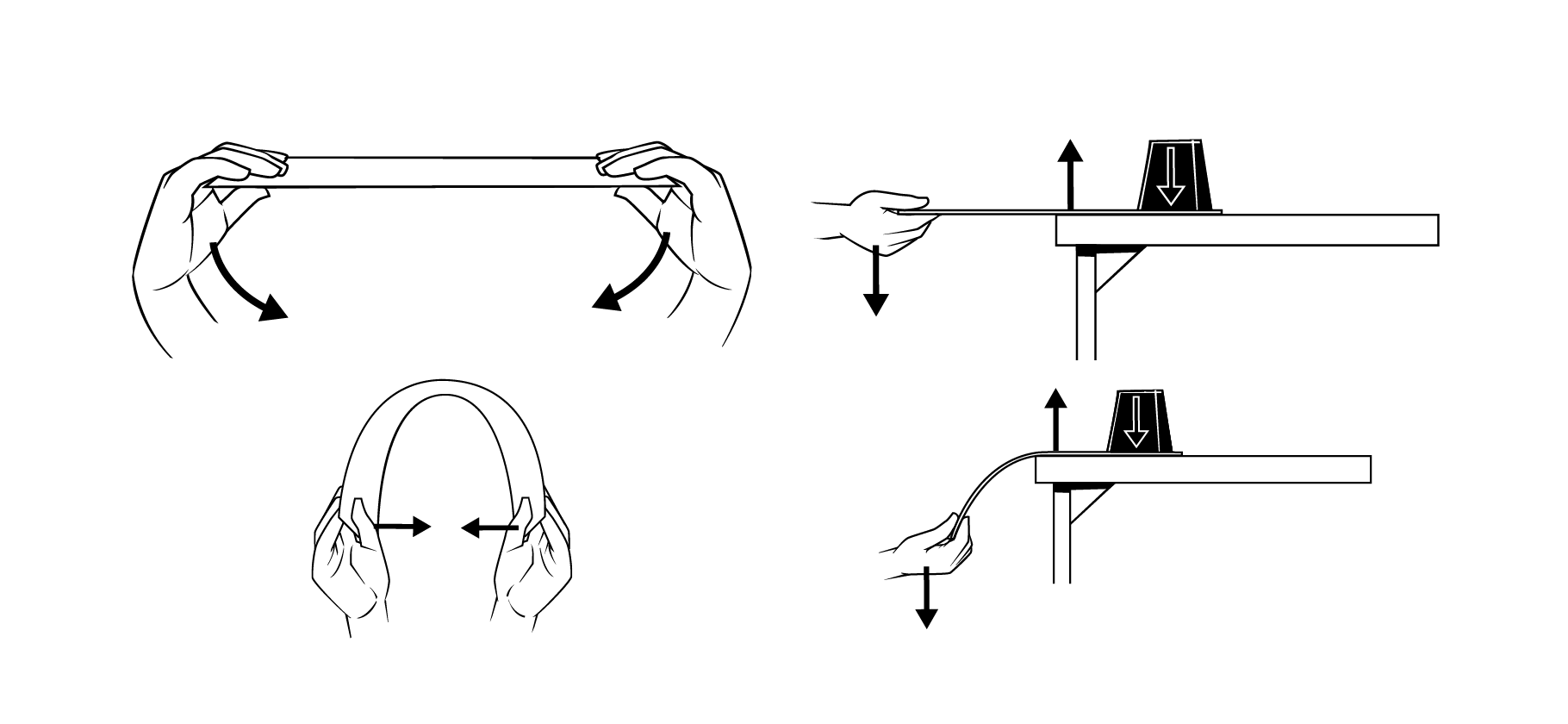
- Stretching: making an object wider or longer by having two opposing forces pulling it.
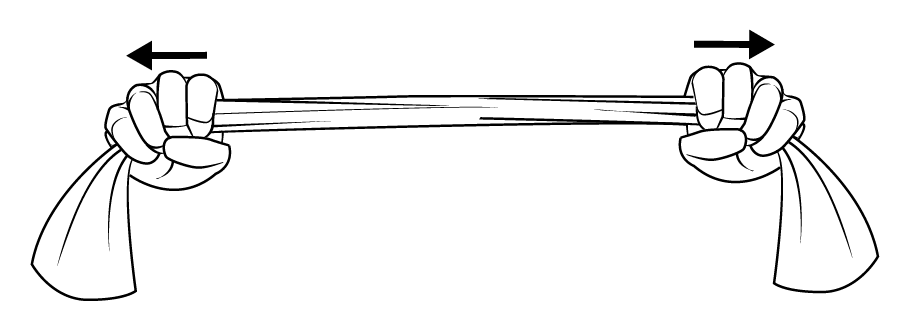
- Scrunching: crunching, crushing or crumpling the object by pushing it towards itself.
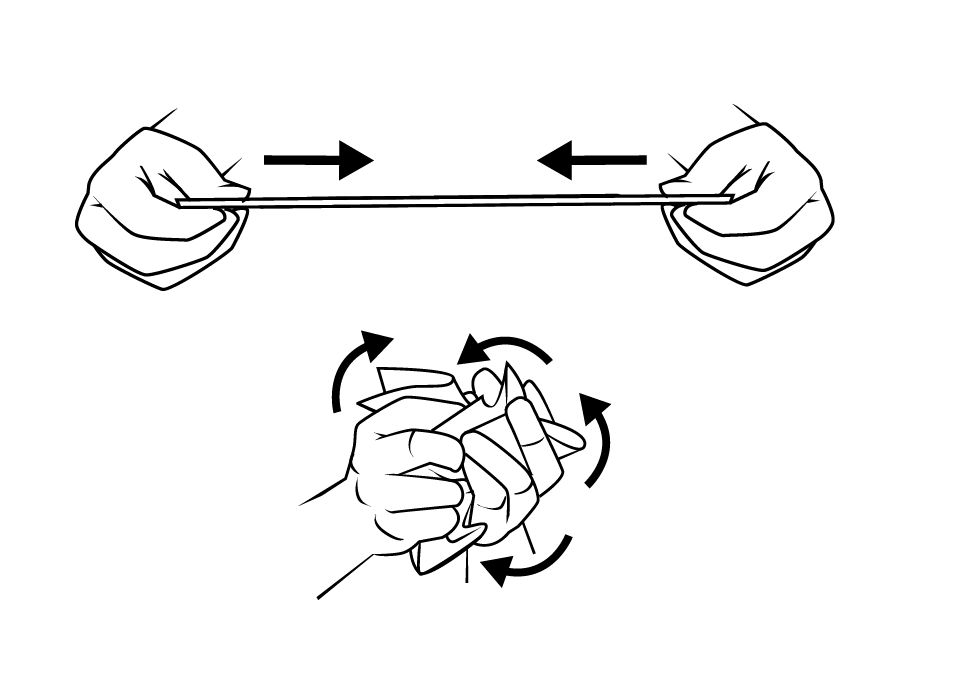
Bending, stretching and scrunching will often cause an object to change shape. Different objects will be changed in different ways depending on their shape, the materials they are made of and the strength and location of the forces applied. For example, rubber bands will return to their original shape and size after being stretched, thin copper wire can be bent and keeps its shape, and a sheet of glass might break if twisted. These are all examples of physical changes. Some physical changes are reversible, such as bending a paper clip. Other physical changes, for example, snapping a popstick, are not reversible.
Changes in state
Heating a substance might cause it to change from one state (solid, liquid, gas) to another. This includes changing from solid to liquid, and liquid to gas. The material remains the same but has a different appearance or shape. By removing heat, the change can often be reversed, that is, the material will change from liquid to solid or gas to liquid. For example, when chocolate is heated sufficiently it changes from a solid to a liquid. When the melted chocolate is cooled it changes back to a solid. In this case, the change is reversible as a new substance was not formed: the liquid is still chocolate.
When a material changes from the solid state to the liquid state, it is called melting. When it changes from the liquid state to the solid state it is called freezing. For each material there is a specific temperature at which this change of state occurs. This is called the ‘melting point’ or ‘freezing point’ of the material depending on which way the state of matter is changing.
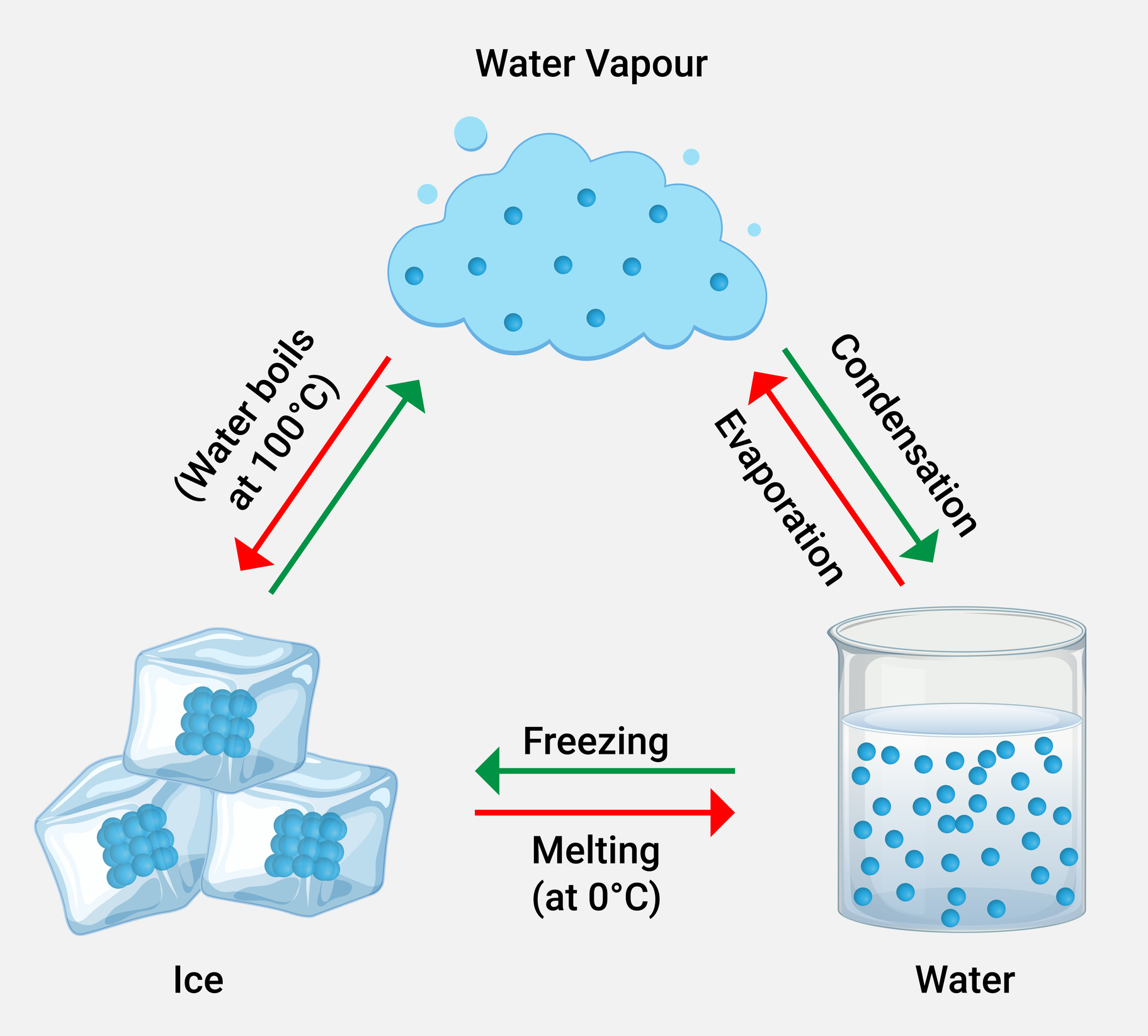
Different changes occur at different rates. A major factor in most change processes is the temperature. Many changes will occur at a faster rate if the temperature is raised. The size of a piece of chocolate and the surrounding temperature are also factors that affect how fast the chocolate will melt. A smaller piece of chocolate will melt faster than a large piece because the heat does not have to penetrate as far. A piece of chocolate in a hot place will melt faster than a piece of chocolate in a cooler place. In order to melt, the temperature of a substance must be raised above its melting point. For this reason, chocolate will never melt in a refrigerator.
When a material changes state, the atoms or molecules do not change. It is the way the atoms or molecules are spaced and held together that changes. Physical changes of state are easily reversible when the materials are ‘pure’ (only containing one type of atom or molecule).
When a non-pure solid (a physical mixture of substances) melts and becomes liquid, sometimes the components can separate. Therefore, when the liquids are put back into the freezer, the original solid might not be re-created. For example, melted and refrozen ice-cream becomes two separate solids: ice and frozen cream.
Some solids undergo chemical reactions when heated and the atoms or molecules react and produce new substances. These reactions are called chemical changes and are not examples of changes of state. For example, wood does not melt when heated but burns (combines with oxygen) instead. Some complex liquids, such as egg white, cook and become solid when they are heated. The nature of the egg white is chemically changed as proteins are broken up, recombine and form new proteins.
Reversible and irreversible changes
Physical change is a change in which no new substance is formed. The object itself might not remain the same, such as, a rock could be ground to powder or a mug could be smashed to pieces, but the material particles are still present. There is still rock and porcelain. Physical change occurs when an object receives or loses energy. This might be from a force, for example, by being hit, or when a substance gains or loses heat energy, such as when an ice cube melts or liquid water freezes.
Chemical change is a change that results in the conversion of the original substances to form new substances. The new chemical substances might be in the form of a gas, liquid or solid. For example, it is easily seen that charcoal is created when toast burns, but the combustion of the cellulose in the bread also produces invisible carbon dioxide and gaseous water. When a substance undergoes a physical change, however, its chemical composition does not change—water is H2O whether it is in the form of a gas (steam), liquid (water), or solid (ice). Common salt—solid sodium chloride—can be recovered from salty water by evaporation and dissolved again to form salty water in which the two components of salt are still present. Sugar crystals can similarly be recovered from sugar-sweetened water without chemical change.
In Year 6 students investigate reversible physical changes (melting, evaporating and dissolving) and irreversible chemical changes (burning and the formation of gas). However, some chemical changes are reversible, for example, the chemical reaction which drives rechargeable batteries. Some physical changes are also irreversible, for example, grinding a log into sawdust.
Some other common changes are:
- Rusting iron, which is caused by the iron particles reacting with water and oxygen to form a new substance (rust). The original metal is changed into a new substance. This is a chemical change.
- Cutting wood is a physical change since the wood changes form. However, if the friction of the chainsaw produces enough heat some of the wood might reach ignition point, in which case some sawdust might burn and undergo a chemical change.
- Bending wire is a physical change, since the object only changes form.
- A glowing tungsten filament in an incandescent light bulb is not a chemical change. The heat and light produced are forms of energy, not new substances. The filament is heated to its ignition point but as there is no oxygen, the wire does not burn—it glows.
- Bubbles appearing in carbonated drinks is a physical change. Carbon dioxide gas was dissolved in the drink at high pressure, and when the pressure was released, the particles come out of solution, become a gas again, and leave the drink.
When some substances undergo physical changes, there can also be some minute chemical changes occurring at the molecular level. These changes are only detectable through scientific testing. For example, when sodium bicarbonate dissolves in water the majority of the change is physical. At the molecular level, some of the sodium bicarbonate and water react to produce a slightly alkaline solution.
Dissolving
When a solid (for example, in a powder form) is added to a liquid, it might dissolve. When this happens the particles of the solid completely disperse in the liquid so that they are no longer visible (not to be confused with a suspension of a solid in a liquid). For example, when table salt is dissolved in water, a liquid solution is formed that contains a dissolved salt. The salt is not changed into another chemical substance: the salt remains as salt but is now dissolved in water.
Not all substances will dissolve in water, for example, nail polish does not dissolve in water but does dissolve in acetone. Some solids will dissolve in water but not in other liquids, for example, aspirin tablets will not dissolve in oil. Whether or not things dissolve depends on the properties of the liquids and the solids, for example, fats will not dissolve in water.
If a powdered solid does not dissolve in a liquid, the liquid will appear cloudy when it is stirred and will become clear again when the powder resettles at the bottom. This is because the solid particles block light more effectively than the liquid does. After adding a soluble powder, a liquid might become cloudy when it is first mixed. This is because it takes time for solids to dissolve. Stirring helps the process by allowing the water to reach as much of the solid as possible.
Liquids such as liquid water can only dissolve a certain amount of a solid at room temperature and pressure. That is why some solid might remain undissolved if too much of a solid is added to the water. The salt or sugar dissolves until the ‘solution is saturated’. You can increase the amount of substance that dissolves in a liquid by increasing the temperature or pressure. Water can dissolve more sugar crystals when it is hot. If the sugar solution is saturated when it is hot, sugar will crystallise from the solution when it cools.
Gases can also dissolve in liquids. ‘Carbonated water’, used for soft drinks, is water in which carbon dioxide gas has been dissolved. The water and gas are put under pressure so more gas is dissolved in the water than would be the case under normal atmospheric conditions. When the pressure is released by opening a bottle or can, the excess carbon dioxide escapes from the water as bubbles.
Irreversible fire
Fire is what we see in the chemical reaction of combustion. This reaction requires three things: heat, fuel and oxygen. ‘Getting the fire started’ literally means creating enough heat for the fire to sustain itself while there is fuel and oxygen available. Once started, the reaction produces heat energy. The fuel provides the chemical energy for the reaction. It is generally carbon-based, such as wood, coal, natural gas, oil or wax. Oxygen from the air reacts with the fuel in the heat of the reaction. Combustion reactions usually produce carbon dioxide gas and water vapour, for example:
candle wax + oxygen → carbon dioxide + water
The wick of a candle burns long enough for the wax to start melting. The liquid wax is drawn up the wick to the flame where it becomes a gas. As a gas, it reacts with the oxygen and heat to generate carbon dioxide and water. This reaction releases energy in the form of heat. The carbon dioxide and water produced are gases; however, the water vapour will condense once away from the heat of the candle. Some wax particles begin to react with the oxygen but leave the candle before they are completely changed; these particles create a black smear where they land.
Substances change and new substances are produced by rearranging atoms; these changes involve energy transfer and transformation.
This list of alternative conceptions is not meant to be comprehensive, but instead aims to provide a starting point.
Alternative conception | Accepted conception |
| Heating a substance always means raising its temperature. | When a substance is undergoing a change in its state (ice to water), it does not immediately change its temperature. |
| Bubbles in boiling water contain air. | Bubbles in boiling water contain water vapour (gas form of water). |
| Steam is water gas | Steam is a very small collection of condensed liquid water suspended in the air. |
| Melting and dissolving are the same. | Melting is a change in state from solid to liquid. Dissolving occurs when a substance (solid) breaks into such small components that they cannot be seen in a solution. |
| Dissolved substances do not take up space. | The volume of water will change when salt is added. |
| When water in a container evaporates, the water has soaked into the container. | Liquid water evaporates and becomes water vapour in the air. |
| Boiling water makes steam which becomes clouds. | Liquid water evaporates and becomes water vapour in the air. As the water vapour cools, it condenses into small collections of liquid water (steam or clouds). |
| Cold water leaks through a glass of water making it wet on the outside. | Water vapour in the air condenses against the cold glass of water forming droplets. |
| An evaporated substance will become lighter if it turns into a gas. | Matter is conserved at all states and its mass does not change. |
| Chemical reactions are irreversible. | Some chemical reactions have an equilibrium where they can be reversed to achieve a balance. |
| Chemical reactions are caused by mixing substances. | Some chemical reactions require energy (usually in the form of heat) to be initiated. Other chemical reactions are spontaneous. |
| Energy is used up in a chemical reaction. | Energy and matter are always conserved in chemical reactions. |
| Matter disappears in a chemical reaction (i.e. fire). | Matter is always conserved in a chemical reaction. |
| Energy/heat/sound is a form of matter | Matter has mass and takes up space. Energy is a quantitative property of a system that can be transferred or transformed. |
| Atoms change during a chemical reaction. | Matter (atoms) are conserved. |
| Smoke is a gas. | Smoke is a combination of small solid particles (often carbon) suspended in the air. |
| The fuel all turns into smoke or carbon dioxide. | The general formula of combustion reactions is fuel + oxygen → carbon dioxide + water |
References
AITSL. (n.d.). Resource. AITSL. https://www.aitsl.edu.au/tools-resources/resource/dispelling-scientific-misconceptions-illustration-of-practice
Allen, M. (2019). Misconceptions in Primary Science 3e. McGraw-hill education (UK).
Ideas for Teaching Science: Years 5-10. (2014, April 14). Resources for Teaching Science. https://blogs.deakin.edu.au/sci-enviro-ed/years-5-10/
Pine, K., Messer, D., & St. John, K. (2001). Children's misconceptions in primary science: A survey of teachers' views. Research in Science & Technological Education, 19(1), 79-96.
Redhead, K. (2018). Common Misconceptions. Primary Science Teaching Trust. https://pstt.org.uk/resources/common-misconceptions/
University of California. (2022, April 21). Correcting misconceptions - Understanding Science. Understanding Science - How Science REALLY Works... https://undsci.berkeley.edu/for-educators/prepare-and-plan/correcting-misconceptions/
